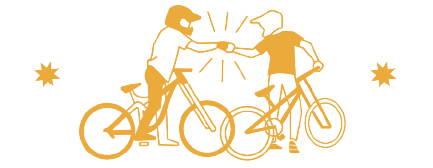Anatomy of drops: What actually goes on, covering standard technique and a variation.
Welcome everyone!
Piyush here from Treadmark, and in this TechTalk video, we’re breaking down something that seems simple on the surface but is packed with nuance: how to ride drops properly.
*Feel free to watch the video and then read the blog for more context.
It’s not about speed, courage, or just “going for it.” While you certainly do need elements of that there’s some real technique involved that can inspire this— and in this video/blog, I want to walk you through exactly why certain movements happen, and how you can use them to ride more safely, more smoothly, and with a lot more comfort.
Setting the Stage: Compression and Control
Zone of compression
We begin the session with a defined drop - I’ve chosen Buckland as this is an incredible asset to Queenstown and 7 Mile (Cheers Nigel and Glen)
Now marked with two red cones highlighting the “zone of compression”, which is the critical space before the lip of the drop where your body is doing some of its most important work.
As I roll in, I begin to compress through my feet, sending weight (through my core and hips) and energy down through the bike. This action generates ‘‘pressure” This pressure is the buildup of stored energy in your system: body + bike together. You're essentially "loading the spring" here.
And here’s the thing — if you don’t compress, if you just roll passively off the drop, your front wheel will dive, leaving gravity to do its work - The nose will drop off the lip before your rear is even ready to leave, and that can lead to nose-heavy landings, sketchy takeoffs, and sometimes worse.
So this compression isn’t optional — it’s essential *This statement is also nuanced and contextual. For eg: If you had loads of speed, you may not need to compress at all.
The Release: Timing the Lift
As I leave the “zone of compression” — marked just before the lip — I release that stored energy, the bike gets lighter beneath me. That’s when I use that lightness to guide the bike towards the ladning, rather than just falling off the edge.
This is where things start to feel really good. The bike moves with me, not underneath me or away from me.
Taking It to Buckland: The Tree Drop Variation
The Buckland - Tree drop
Now that we’ve laid the foundation, we take the lesson to a steeper drop — the well-known tree drop on Buckland.
This one’s got a sharper gradient, which changes how the body must behave. As I approach the edge, I naturally get lower and closer to the bike (Read blog on steeps, for a deeper understanding). This is a conscious movement - My body knows what’s coming, and it's already preparing.
That change in gradient causes me to combine getting lower and closer to the bike and press more actively into the bike, especially as I roll toward the takeoff. And this time, there’s an added move: I do an active front wheel lift. Not a yank or a bunny hop, but a controlled lift that keeps the bike level as I drop in.
And then — boom. Both wheels touch down smoothly, and I ride away clean.
So, What did we just learn?
That even the most natural-feeling drops are built on technique.
- Pressing through the feet builds pressure with control.
- Releasing at the right moment gives you time, space, and direction towards the landing.
- Steeper gradients demand a more dynamic body movements, adapted and relative to the feature itself.
If you’re out there trying to get smoother over drops or are just starting to explore small step-downs and compressions, this is the foundation to build on. Don’t skip the setup.
Learn to feel the press and timing the lift/release like a pro.
📍 Want to learn these movements in person?
Come train with us at Treadmark in Queenstown. We'll coach you step by step — and help you feel confident on every feature.
📧 Have questions? Contact us at management@treadmark.co.nz





